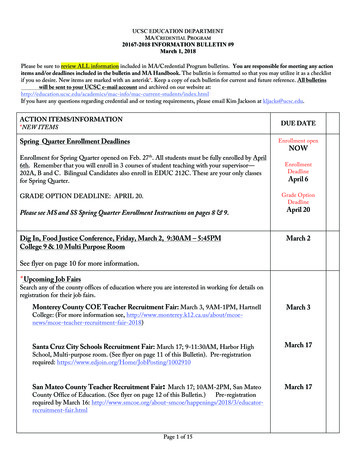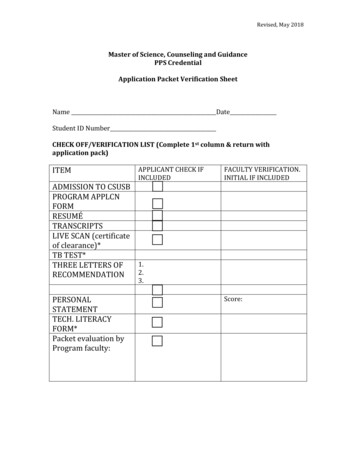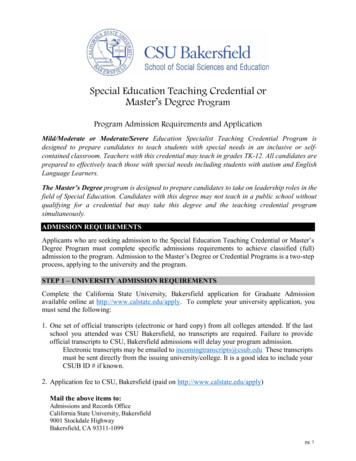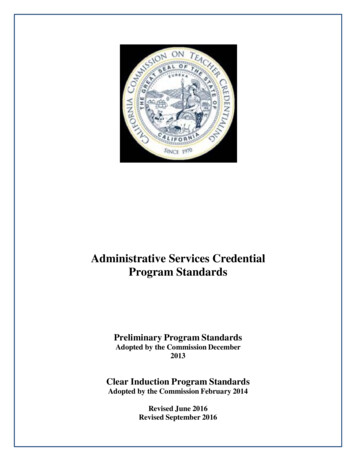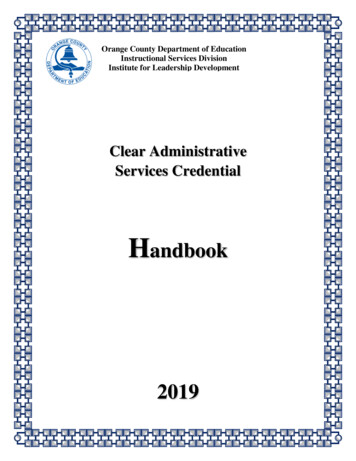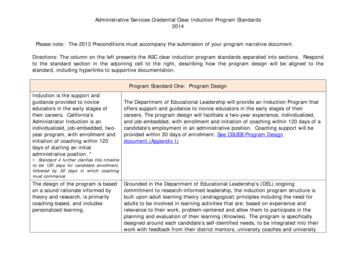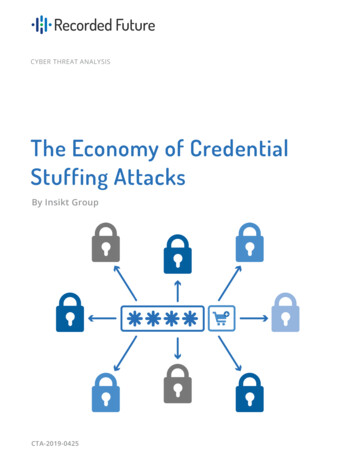
Transcription
CYBER THREAT ANALYSISThe Economy of CredentialStuffing AttacksBy Insikt GroupCTA-2019-0425
CYBER THREAT ANALYSISThis report covers the current threat landscape of credential stuffing attacks. It reviewsthe most popular tools used by cybercriminals to initiate credential stuffing anddescribes some of the most popular marketplaces that sell compromised credentials.This report contains information gathered using the Recorded Future Platform, as wellas additional open source, dark web, and underground forum research, and will be ofmost interest to analysts protecting e-commerce, telecommunications, and financialorganizations from credential stuffing attacks, as well as those looking for investigativeleads on threat actors performing such attacks.Executive SummaryThe rapid proliferation of automated marketplaces on the darkweb, fueled by the widespread availability of support infrastructuresuch as account-checking software, email and password combolists, and proxy service providers, has created the perfect attacklandscape for the abuse of thousands of popular web servicessuch as e-commerce, financial services, travel websites, andtelecommunications companies. It is safe to assume that almostevery large organization with an online retail presence has had theirusers exposed to credential stuffing attacks in the past few years,with some companies having upwards of millions of exposed logincredentials available for purchase on the dark web at any givenmoment.Key Judgments The first widespread credential stuffing attacks were observedin late 2014, coinciding with the proliferation of automatedunderground marketplaces. When selling accounts, attackersoffered the quick and easy monetization of compromisedaccount credentials. Some actors who engaged in credentialstuffing attacks remain active today. With an investment of as little as 550, criminals couldexpect to earn at least 20 times the profit on the sale ofcompromised login credentials. The overall supply of compromised login credentials acrossseveral large marketplaces exceeds tens of millions ofaccounts. Insikt Group identified at least six popular variants of accountchecking software used by cybercriminals; however, dozens oflesser-known variants can be found on the dark web.Recorded Future www.recordedfuture.com CTA-2019-0425 1
CYBER THREAT ANALYSIS While some companies may choose to implement multi-factorauthentication (MFA), which blocks the credential stuffingattack vector, organizations may not be prepared to choosesecurity over convenience.BackgroundAround late 2014 and in the beginning of 2015, we observed thewidespread adoption of new dark web business models specificallytailored to facilitate a high volume of trades in a fully automatedmanner. Designed to emulate legitimate retail platforms suchas eBay and Amazon, these so-called “automated shops” alloweven low-level criminals to become vendors of stolen data, suchas compromised login credentials, without having to worry aboutmaintaining their own infrastructure or marketing campaigns. Byand large, the adoption of account marketplaces was made possibleprimarily by the proliferation of account-checking software, orsimply “checkers,” used as the main tool in credential stuffingattacks.Threat AnalysisCompromised account credentials were always a valuable commodityin the dark web — the number of transactions was relatively small,and they were primarily conducted either on a peer-to-peer basisor via semi-automated markets such as AlphaBay, Silk Road, andHansa Market. In older models, buyers received their wares onlyafter the seller manually approved the deal and delivered thepurchased data. Moreover, sellers had to maintain the listings andcommunicate with the buyers personally.However, with the advent of automated shops, the need for manualengagement was eliminated and the business of compromisedaccounts fully transitioned from peer-to-peer dealings to a muchmore democratized, open-to-everyone enterprise.Recorded Future www.recordedfuture.com CTA-2019-0425 2
CYBER THREAT ANALYSISFor a nominal 10 to 15 percent commission deducted from theamount of each sale, members can upload any number of validatedcompromised accounts, which in addition to email and password,often include data such as the account holder’s city or state ofresidency, transaction history, and/or account balance. All of this isvaluable data to fraudsters seeking to buy accounts tailored to theirspecific needs. The vendor’s main focus is replenishing the stock,while all customer support, remittances, and dispute resolutionsare handled by the shop’s support team.Automatic shop listings. Alongside the compromised company name, buyers can see the available balance or loyalty points, the account holder’s place of residency,associated payment cards, the date of the last transaction, and a hostname of the account holder’s login email.At first, only a handful of select vendors became the primary suppliersof stolen data, but as the tradecraft was shared among membersof the criminal underground, the business of stolen credentials hasgrown exponentially.Since regular internet users tend to reuse the same passwordsacross multiple websites, threat actors quickly learned that insteadof attempting to obtain access to an individual account, which maytake a very long time, they should instead focus on hacking multiplerandom accounts, reducing their efforts.Recorded Future www.recordedfuture.com CTA-2019-0425 3
CYBER THREAT ANALYSISSlilpp automatic shop listings.A combination of several elements made the hacking of variousonline services accounts not just effortless, but also incrediblylucrative. To launch account brute-forcing, also known as credentialstuffing attacks, an attacker only needed brute-forcing software, adatabase of random email and password combinations, and accessto a pool of proxies.Recorded Future www.recordedfuture.com CTA-2019-0425 4
CYBER THREAT ANALYSISThe EconomicsEarly versions of checkers were made to target a single companyand were sold for between 50 and 250, depending on the tool’scapabilities. These tools would attempt to log in to a website usingan email and password combination obtained from a randomdatabase often obtained on the dark web. If a combination worked,it would be marked as valid. If not, the software would simply pickanother combination from the list and attempt to log in again. Forvalid logins, more expensive and complex checkers would alsocollect additional information from the compromised account, suchas linked banking and payment card information, account balances,the owner’s address, and even transaction history. Until this day, theingenuity of the method truly lies in the economy of scale, allowingcriminals to process hundreds of thousands of combinations in avery short period of time.Eventually, several dominant players such as STORM, Black Bullet,and Sentry MBA entered the market with more robust tools,supporting an unlimited number of custom plugins, also called“configs,” which essentially offered hackers the capability to targetalmost any company with an online retail presence.What had initially started as several hundred or several thousandcompromised accounts quickly ballooned to hundreds of thousands,or even millions, of accounts. Some of the most prominent accountshops have tens of millions of compromised accounts for sale atany given moment.Although the competition quickly brought the average price of asingle compromised account from over 10 down to a mere 1 to 2, the overall profitability of credential stuffing attacks increasedsignificantly through sheer volume.According to underground chatter observed over time, the averagesuccess rate for credential stuffing is anywhere between one tothree percent. Hence, for every one million random combinationsof emails and passwords, attackers can potentially compromisebetween 10,000 and 30,000 accounts. Moreover, the same databasecould then be reused over and over again to hack dozens of differentwebsites, yielding even higher profits.Recorded Future www.recordedfuture.com CTA-2019-0425 5
CYBER THREAT ANALYSISBased on a conservative success rate of one percent per 100,000 compromised emails and passwords, the economics behind credentialstuffing attacks reveals at least 20 times higher profit levels.Recorded Future www.recordedfuture.com CTA-2019-0425 6
CYBER THREAT ANALYSISTechnical AnalysisBelow are the most prominent variants of account-checkingsoftware used by cybercriminals in credential stuffing campaigns.It is important to note that lesser-known solutions, which are oftenbuilt to target a single company, are also available for purchase.However, such one-off tools rarely gain significant market presenceand tend to disappear quickly, as the developers cease productsupport due to slow adoption.STORMSTORM is marketed across several English-speаking forums, andunlike other account-checking tools, is available free of charge.However, users are encouraged to make donations. The exactidentity of the developer is unknown; however, according tounderground forum chatter, the software was allegedly created bythe actor mrviper. STORM was first launched in January 2018, andaccording to the description found on dark web advertisements, itis characterized as a free “cracking” program designed to performwebsite security testing. STORM is written in C language and wasdeveloped in close cooperation with members of the Crackedforum. The tool has the following technical features: Supports FTP cracking Simultaneous FTP and HTTP attacks Concurrent sessions Debug functionality for activity analysis Supports combo lists of up to 20 million email:passwordrecords Supports HTTP/HTTPS Supports SOCKS4 and SOCKS5 Proxy auto update with automated harvesting from publicsources Keywords capture (collection of premium account details) JavaScript redirectRecorded Future www.recordedfuture.com CTA-2019-0425 7
CYBER THREAT ANALYSISSTORM account cracker advertisement on the dark web.Black BulletBlack Bullet first appeared on the dark web in early 2018 and likelywas created by the actor Ruri, who operates the official www.bullet[.]black website; however, according to the information found on themain page, the community no longer accepts new members. Severalmembers of the dark web, including daltonbean8 and Doberman,were observed distributing the tool.In contrast to other account-checking tools, BlackBullet does notoffer multi-threaded capabilities, and only allows a single companyat a time to be attacked. The tool also comes with a brute-forcingfeature that can perform dictionary attacks when run againstspecific accounts. Captchas bypass Configuration files: 530; however, users have an option tomodify and create new configurations themselves Selenium Webdriver support Price: Between 30 and 50Recorded Future www.recordedfuture.com CTA-2019-0425 8
CYBER THREAT ANALYSISBlackBullet V.2.0.2 control panel interface.Private KeeperPrivate Keeper was developed by the actor deival909. Accordingto the description provided by the actor, the tool is based on inline technology. Private Keeper is by far the most popular accountchecking software in the Russian-speaking underground. Price: From 49 Russian rubles (approximately 0.80) Concurrent sessions Utility software to aid in automated connection to the privateor publicly available proxy services Official online store: www.deival909[.]ru Latest version: 7.9.3.34Recorded Future www.recordedfuture.com CTA-2019-0425 9
CYBER THREAT ANALYSISPrivate Keeper control panel interface.SNIPRSNIPR was sold and publicly shared on multiple undergroundforums. The threat actor PRAGMA is the developer of the malware.SNIPR is a configurable account-checking software, written in Clanguage that supports both online credential stuffing and offlinebrute-forcing dictionary attacks. Although the tool was advertisedby multiple threat actors, this account checker has its own websitewith a forum and a marketplace www.snipr[.]gg. The website allowsthird party developers to share custom-made configuration files. Configuration files: More than 100 are part of the officialpackage Concurrent attacks: Up to four targets Price: 20Recorded Future www.recordedfuture.com CTA-2019-0425 10
CYBER THREAT ANALYSISOver 100 config files are included in the SNIPR account checker by default.Sentry MBASentry MBA, with over 1,000 configuration files available, is oneof the most prominent and readily available examples of accountchecking software on the dark web. Several criminal forumsmaintain ongoing discussion threads dedicated to Sentry MBA.As of December 2018, the registration at https://sentry[.]mba, theofficial Sentry MBA marketplace and discussion board, is closed andavailable by invitation only. Insikt Group identified that the tool hasbeen actively advertised on the dark web since late 2014. However,the official Twitter account was launched in July 2013. The tool wasallegedly developed by an actor using the alias “Sentinel” and latermodified by another actor, “Astaris.” Sentry MBA uses OCR (opticalcharacter recognition) functionality to bypass captcha. However,Sentry MBA doesn’t support Javascript anti-bot challenges. SentryMBA can be configured to recognize specific keywords associatedwith a website’s responses to successful and unsuccessful loginattempts. Available Configs: More than 1000 Official Website: https://sentry[.]mba Price: Between 5 and 20 per configuration file Supports HTTP/HTTPS Supports SOCKS4 and SOCKS5Recorded Future www.recordedfuture.com CTA-2019-0425 11
CYBER THREAT ANALYSISSentry MBA control panel.WOXYUnlike a typical account-checking software, the WOXY email checkerallows criminals to verify the validity of email accounts, scan emailcontent for valuable information (like gift card codes or onlinesubscriptions to streaming services,
and Sentry MBA entered the market with more robust tools, . “configs,” which essentially offered hackers the capability to target almost any company with an online retail presence. What had initially started as several hundred or several thousand compromised accounts quickly ballooned to hundreds of thousands, or even millions, of accounts. Some of the most prominent account shops have .



